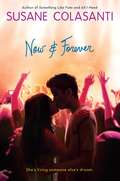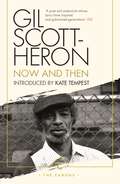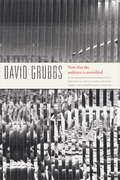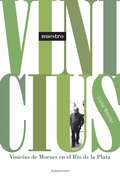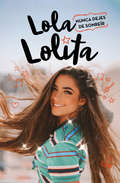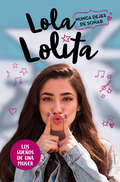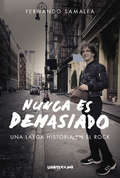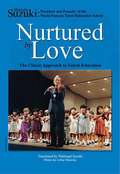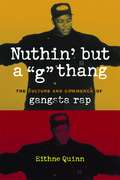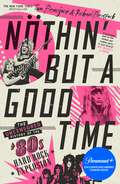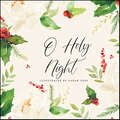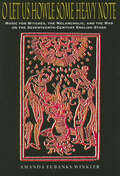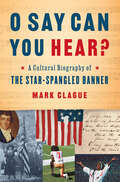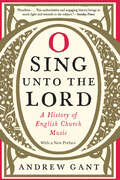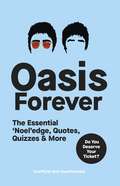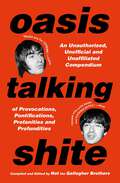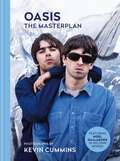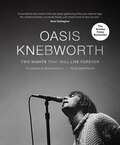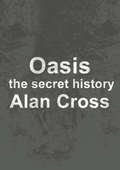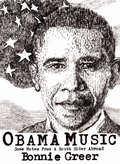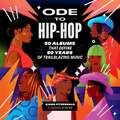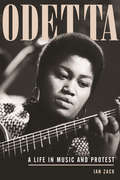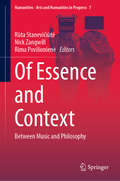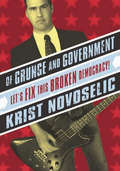- Table View
- List View
Now and Forever
by Susane ColasantiWhat if your boyfriend was the world's biggest rockstar? Sterling is crazy in love with Ethan. Not only is he the sweetest boy she's ever met, but he's an incredibly talented guitarist, singer, and songwriter. And since forever, he's believed he has what it takes to be a star. When Ethan becomes an overnight sensation, he's thrown head-first into the glam world of celebrity--and so is Sterling. Before she knows it, she's attending red-carpet premieres, getting free designer clothes, and flying around the country to attend Ethan's monumental sold-out concerts. It's a dream come true...but whose dream is Sterling living? And what do you do when "forever" comes to an end?
Now and Then: The Poems Of Gil Scott-heron (Canons #101)
by Gil Scott-HeronA wide-ranging collection of poetry by the iconic &“poet and polemicist whose lyrics have inspired and galvanized generations&” (GQ). Musician, poet, and spoken-word artist Gil Scott-Heron influenced generations of artists with his highly original, disarmingly witty, politically provocative song-poems. Coming into prominence in the early 1970s, the self-proclaimed &“bluesologist&” has earned, among many other accolades, the title of Godfather of Rap. Now and Then presents a collection of poems from across Scott-Heron long career—including some of his most iconic recorded pieces, as well as lesser-known works that have never been recorded. With an introduction by Kate Tempest, this collection carries the reader from the global topics of political hypocrisy and the dangers posed by capitalist culture to painfully personal themes and the realities of everyday life. Through it all, Scott-Heron&’s message is both steeped in history and as urgent as ever.&“Scott-Heron is such a fine writer…the least likely pop star ever, one with a truly brilliant mind&”—Sunday Times, UK &“Some of the funniest and most literate lyrics in all music . . . From deadpan attacks on racism to withering sarcasm about the Great Society; from Chomskian rants to parodies of media shallowness—every line comes coated in a sardonically witty turn of phrase.&”—Time Out
Now that the audience is assembled
by David GrubbsFollowing his investigation into experimental music and sound recording in Records Ruin the Landscape, David Grubbs turns his attention to the live performance of improvised music with an altogether different form of writing. Now that the audience is assembled is a book-length prose poem that describes a fictional musical performance during which an unnamed musician improvises the construction of a series of invented instruments before an audience that is alternately contemplative, participatory, disputatious, and asleep. Over the course of this phantasmagorical all-night concert, repeated interruptions take the form of in-depth discussions and musical demonstrations. Both a work of literature and a study of music, Now that the audience is assembled explores the categories of improvised music, solo performance, text scores, instrument building, aesthetic deskilling and reskilling, and the odd fate of the composer in experimental music.
Nuestro Vinicius: Vinicius de Moraes en el Río de la Plata
by Liana WennerEsta biografía recorre los momentos menos conocidos de la vida delbrasileño nómade que interpretó la bossa nova no solo como un géneromusical, sino como una actitud ante la vida. «Nuestro Vinicius» es un exquisito perfil coral del último Vinicius. Elpoeta y músico genial que eligió las calles porteñas y uruguayas tras elexilio, para difundir su arte y pasarla bien con amigos. Noctámbulo,bohemio, gran bebedor de whisky, padre ausente, mujeriego y excéntrico,Vinicius le cantó #como dice Liana Wenner- a la libertad individual, laalegría, la sofisticación y la promesa de la realización de lasfantasías sexuales.
Nunca dejes de sonreír: Los sueños de una muser (Lola Lolita #Volumen 3)
by Lola MorenoLola Lolita, ¡la tercera aventura de la estrella de Tik Tok! Nunca dejes de sonreír con @lolaloliitaaa Hay una pequeña cosita inevitable que siempre hay que sufrir antes de poder irte vacaciones... ¡los exámenes de final de curso! ¡Glups! Y en el caso de Lola este año no eran lo que se dice unos exámenes normalitos, si no la temible selectividad. ¡Doble glups! Sumergida entre apuntes, Lola no paraba de pensar en todas las cosas guays que haría durante las vacaciones: tomar el sol, navegar en barquito, hacer paddle surf… Y por fin llegó el día. Carla, Ana, Lucia y ella estaban ready para pasar el mejor verano de su vida. ¡No tenían ni idea de que aquellas vacaciones serían mucho más moviditas de lo que jamás habrían imaginado!¡Menudas vacaciones más top! {Nunca dejes de sonreír con @lolaloliitaaa}
Nunca dejes de soñar: La historia de una muser (Lola Lolita #Volumen 2)
by Lola MorenoLola Lolita, ¡las aventuras de la estrella de Musical·ly! Nunca dejes de soñar con @lolaloliitaaa Hoy empieza un nuevo curso y Lola se muere de ganas por reencontrarse con los Tumblr, ¡su grupito de baile! Este año lo van a hacer todavía mejor, todos tienen un montón de ideas para organizar un espectáculo increíble. Lo que no se esperan es lo que va a suceder... Valeria, la nueva compañera del insti, se va a convertir en su máxima rival. Resulta que Valeria baila desde pequeña y está montando un baile para competir con Lolita y su grupo... ¡la disputa entre musers está asegurada! ¿Quién será la más votada?
Nunca es demasiado: Una larga historia en el rock
by Fernando SamaleaCierre de la trilogía autobiográfica del mayor baterista argentino de rock, que abarca el período 2010-2017: de Charly & The Prostitution, las giras, el Colón y su disco Random a los conciertos europeos con el francés Benjamin Biolay. Dear Fernando, qué bueno tener este libro con nuevas y divertidas aventuras. Hemos compartido muchas de ellas. Los libros y la música nos juntaron siempre... ¡Me faltaría subir a tu moto!Renata Schussheim Siempre hay un soldado, un jugador, que se especializa en proveer el clima ideal para la aventura. Que sabe vehicular y contagiar la energía necesaria para una celebración. Esta es una de las mayores virtudes de Fernando. Virtud que solo puede poseer una sensibilidad distinta como la suya.Ramón Ortega «Después de la tempestad viene... otra tempestad», dice Fernando Samalea al empezar este recorrido por sus vivencias más recientes. Amigos, conciertos, viajes, amores, paisajes, en estas páginas todo transcurre con la naturalidad de lo extraordinario. Samalea salta desde el Colón con Charly hasta el barcito de provincia con músicos veinteañeros; va de Nueva York a París, de Arequipa a Kioto; cambia el altillo de Constitución por el Barco de Villa Ortúzar. Abandona, durante un tiempo, ómnibus y aviones para subir a su querida Idílica y conquistar en dos ruedas casi toda Sudamérica. No conforme con la percusión y el fueye, con The Prostitution, la Orquesta Hypnofón y el Sexteto Irreal, también es bartender. Y como si ser Samalea no fuera suficiente, algunos lo llaman Palito y otros le piden autógrafos de Julio Bocca. Nunca es demasiado.
Nurtured by Love: The Classic Approach to Talent Education, 2nd Edition
by Shinichi Suzuki Waltraud SuzukiThis is typically required reading for parents of children studying music via the Suzuki Method. It discusses Suzuki's philosophy of talent education and methods for raising a musical child with good character.
Nuthin' but a "G" Thang: The Culture and Commerce of Gangsta Rap (Popular Cultures, Everyday Lives)
by Eithne QuinnIn the late 1980s, gangsta rap music emerged in urban America, giving voice to—and making money for—a social group widely considered to be in crisis: young, poor, black men. From its local origins, gangsta rap went on to flood the mainstream, generating enormous popularity and profits. Yet the highly charged lyrics, public battles, and hard, fast lifestyles that characterize the genre have incited the anger of many public figures and proponents of "family values." Constantly engaging questions of black identity and race relations, poverty and wealth, gangsta rap represents one of the most profound influences on pop culture in the last thirty years.Focusing on the artists Ice Cube, Dr. Dre, the Geto Boys, Snoop Dogg, and Tupac Shakur, Quinn explores the origins, development, and immense appeal of gangsta rap. Including detailed readings in urban geography, neoconservative politics, subcultural formations, black cultural debates, and music industry conditions, this book explains how and why this music genre emerged. In Nuthin'but a "G" Thang, Quinn argues that gangsta rap both reflected and reinforced the decline in black protest culture and the great rise in individualist and entrepreneurial thinking that took place in the U.S. after the 1970s. Uncovering gangsta rap's deep roots in black working-class expressive culture, she stresses the music's aesthetic pleasures and complexities that have often been ignored in critical accounts.
Nöthin' But a Good Time: The Uncensored History of the '80s Hard Rock Explosion
by Tom Beaujour Richard BienstockNow streaming on Paramount+ as an exclusive docuseries!The New York Times BestsellerThe Explosive National Bestseller"A backstage pass to the wildest and loudest party in rock history—you'll feel like you were right there with us!" —Bret Michaels of PoisonNothin' But a Good Time is the definitive, no-holds-barred oral history of 1980s hard rock and hair metal, told by the musicians and industry insiders who lived it. Hard rock in the 1980s was a hedonistic and often intensely creative wellspring of escapism that perfectly encapsulated—and maybe even helped to define—a spectacularly over-the-top decade. Indeed, fist-pumping hits like Twisted Sister’s “We’re Not Gonna Take It,” Mötley Crüe’s “Girls, Girls, Girls,” and Guns N’ Roses’ “Welcome to the Jungle” are as inextricably linked to the era as Reaganomics, PAC-MAN, and E.T.From the do-or-die early days of self-financed recordings and D.I.Y. concert productions that were as flashy as they were foolhardy, to the multi-Platinum, MTV-powered glory years of stadium-shaking anthems and chart-topping power ballads, to the ultimate crash when grunge bands like Nirvana forever altered the entire climate of the business, Tom Beaujour and Richard Bienstock's Nothin' But a Good Time captures the energy and excess of the hair metal years in the words of the musicians, managers, producers, engineers, label executives, publicists, stylists, costume designers, photographers, journalists, magazine publishers, video directors, club bookers, roadies, groupies, and hangers-on who lived it. Featuring an impassioned foreword by Slipknot and Stone Sour vocalist and avowed glam metal fanatic Corey Taylor, and drawn from over two hundred author interviews with members of Van Halen, Mötley Crüe, Poison, Guns N’ Roses, Skid Row, Bon Jovi, Ratt, Twisted Sister, Winger, Warrant, Cinderella, Quiet Riot and others, as well as Ozzy Osbourne, Lita Ford, and many more, this is the ultimate, uncensored, and often unhinged, chronicle of a time where excess and success walked hand in hand, told by the men and women who created a sound and style that came to define a musical era—one in which the bands and their fans went looking for nothin’ but a good time…and found it.
O Holy Night
by Sarah CraySpread a little Yuletide cheer with Sarah Cray’s fourth book, O Holy Night. Beautiful watercolor, gouache, and ink illustrations are paired with beloved Christmas carols in this elegant hardbound volume. Allow it to serve as a charming host gift, a personal songbook, or to complement your holiday decor. The featured carols include lyrics from select stanzas of O Holy Night, Silent Night, O Little Town of Bethlehem, Hark the Herald Angels Sing, and Joy to the World—classic hymns to bring you right back to cherished moments of Christmas from years past, and to build fond new memories for Christmases yet to come.
O Let Us Howle Some Heavy Note: Music for Witches, the Melancholic, and the Mad on the Seventeenth-Century English Stage
by Amanda Eubanks WinklerIn the 17th century, harmonious sounds were thought to represent the well-ordered body of the obedient subject, and, by extension, the well-ordered state; conversely, discordant, unpleasant music represented both those who caused disorder (murderers, drunkards, witches, traitors) and those who suffered from bodily disorders (melancholics, madmen, and madwomen). While these theoretical correspondences seem straightforward, in theatrical practice the musical portrayals of disorderly characters were multivalent and often ambiguous.O Let Us Howle Some Heavy Note focuses on the various ways that theatrical music represented disorderly subjects--those who presented either a direct or metaphorical threat to the health of the English kingdom in 17th-century England. Using theater music to examine narratives of social history, Winkler demonstrates how music reinscribed and often resisted conservative, political, religious, gender, and social ideologies.
O Say Can You Hear?: A Cultural Biography Of The Star-spangled Banner
by Mark ClagueThe fascinating story of America’s national anthem and an examination of its powerful meaning today. Most Americans learn the tale in elementary school: During the War of 1812, Francis Scott Key witnessed the daylong bombardment of Baltimore’s Fort McHenry by British navy ships; seeing the Stars and Stripes still flying proudly at first light, he was inspired to pen his famous lyric. What Americans don’t know is the story of how this everyday “broadside ballad,” one of thousands of such topical songs that captured the events and emotions of early American life, rose to become the nation’s one and only anthem and today’s magnet for controversy. In O Say Can You Hear? Mark Clague brilliantly weaves together the stories of the song and the nation it represents. Examining the origins of both text and music, alternate lyrics and translations, and the song’s use in sports, at times of war, and for political protest, he argues that the anthem’s meaning reflects—and is reflected by—the nation’s quest to become a more perfect union. From victory song to hymn of sacrifice and vehicle for protest, the story of Key’s song is the story of America itself. Each chapter in the book explores a different facet of the anthem’s story. In one, we learn the real history behind the singing of the anthem at sporting events; in another, Clague explores Key’s complicated relationship with slavery and its repercussions today. An entire is chapter devoted to some of the most famous performances of the anthem, from Jimi Hendrix at Woodstock to Roseanne Barr at a baseball game to the iconic Whitney Houston version from the 1991 Super Bowl. At every turn, the book goes beyond the events to explore the song’s resonance and meaning. From its first lines Key’s lyric poses questions: “O say can you see?” “Does that banner yet wave?” Likewise, Clague’s O Say Can You Hear? raises important questions about the banner; what it meant in 1814, what it means to us today, and why it matters.
O Sing unto the Lord: A History of English Church Music
by Andrew GantThis history of English church music is “one of the wittiest and most whimsically irreverent works of scholarship in recent memory” (The Christian Century).For as long as people have worshipped together, music has played a key role in church life. Here, Andrew Gant offers a fascinating history of English church music, from the Latin chant of late antiquity to the great proliferation of styles seen in contemporary repertoires.The ornate complexity of pre-Reformation Catholic liturgies revealed the exclusive nature of this form of worship. By contrast, simple English psalms, set to well-known folk songs, summed up the aims of the Reformation with its music for everyone. The Enlightenment brought hymns, the Methodists and Victorians a new delight in the beauty and emotion of worship. Today, church music mirrors our multifaceted worldview, embracing the sounds of pop and jazz along with the more traditional music of choir and organ. And reflecting its truly global reach, the influence of English church music can be found in everything from masses sung in Korean to American Sacred Harp singing.From medieval chorales to “Amazing Grace,” West Gallery music to Christmas carols, English church music has broken through the boundaries of time, place, and denomination to remain familiar and cherished everywhere. O Sing unto the Lord is the biography of a tradition, a book that “celebrates the sheer pleasure of raising a joyful sound to the Lord” (The Guardian).“What, fundamentally, is the function of church music, and why have clerical authorities often been suspicious of how much attention music receives? Gant engages these questions in intelligent, energetic prose.” —Publishers Weekly“Excellent . . . this authoritative and engaging history brings so much light and warmth to the subject.” —Sunday Times“The beauty of relating Christian history this way is that it broadens the focus to include the listening laity, not just the clergy or the church establishment.” —Foreword Reviews
Oasis Forever: The Essential ‘Noel’edge, Quotes, Quizzes & More
by Pop PressThe ultimate Christmas gift for this 'Noël'!Show your loyalty to the ultimate Rock ’n’ Roll Stars with this Supersonic celebration of the Gallagher brothers. Featuring Liam and Noel’s most outrageous quotes and the quizzes and questions you need to prove you deserve to be at the concerts more than anyone else, this is the ultimate celebration of the band that defined an era.Learn:Where Oasis recorded their iconic first albumWhat Noel said about Liam after the band broke up in 2009Which Oasis song is Liam’s favouriteAnd more…
Oasis Talking Shite
by Not the Gallagher BrothersA hilarious unofficial tribute to the most opinionated and entertainingly cantankerous band in rock and roll history.Hello and listen up. In 1994, with the shock of the lightning that was Oasis&’s force-of-nature debut album, the British band&’s cigarettes-and-alcohol-fueled founding brothers Liam and Noel Gallagher went supernova all around the world. Most artists would have responded to this fame by opting to cast no shadow, saying less in public, or at least being more cautious when they did, reluctant to add to the weight of the world on their shoulders. Not Liam and Noel, who did a strange thing. As if born on a different cloud, they refused to be quiet ones and acquiesce to the typical masterplan for celebrity. For the next thirty years, they never stopped opening their big mouths and shouting out loud their opinions on everything underneath the sky. Whether as stormy as a cloudburst, as playful as a shakermaker, as wise as a headshrinker in a rockin&’ chair, as uncouth as a girl in a dirty shirt with mucky fingers, or as lewd as fuckin&’ in the bushes, their heathen chemistry was always electric—some might say as addictive as morning glory. Oasis Talking Shite celebrates these songbirds&’ refreshing candor, constructing a magic pie of memorable quotes and photographs into a wall of wonder. Here they go let it out on nearly every topic imaginable, including religion, politics, technology, sports, aging, America, aliens, the Big Bang Theory, open-toed shoes, Christmas, SpongeBob SquarePants, other bands, and of course their all-time favorite subject: each other. Timed to the long-awaited Oasis reunion tour in summer 2025, in which they are keeping the dream alive despite just getting older, this book will help you stop crying your eyes out if you didn&’t get tickets. In fact, it&’s an eyeball tickler. D&’you know what I mean? It&’s something to read while waiting for the rapture. It won&’t let you down and gives you something about which to talk tonight or on a Sunday morning call—an opportunity to look back in appreciation (not anger) as well as a reminder of why Liam and Noel will never slide away and definitely (not maybe) live forever as two of the most supersonic rock &‘n&’ roll stars to ever turn up the sun. So put yer money where yer mouth is, bring it on down to the bookstore register, and bag it up.
Oasis The Masterplan: Photographs by Kevin Cummins, featuring Noel Gallagher in his own words
by Kevin Cummins'This book really brings those early years back to me. Kevin's photographs captured us at the very beginning. This is a must-have book for every Oasis fan.' Noel Gallagher'As iconic photographer, adventurous fan and inside eye-witness, Kevin Cummins has always been where the cultural action is.' Paul Morley"Cummins, typical Manc, combining art with a good time, a sense of beauty, which explains the iconic shots of Liam and Noel in Man City shirts: memorable, defining images." - Miranda Sawyer, Observer'No one has captured the look of alternative UK music over the past half a century more tellingly than Kevin Cummins.' Simon Armitage***How does a band come into being? What are the myriad forces that shape their sound, look and identity? In 1993, Oasis signed to Creation Records and were shortly to begin recording their first album. The following year began with a masterplan - the creation of Oasis. At the centre of this enterprise was celebrated photographer Kevin Cummins, brought on board to help the band find a look that fitted their sound. In Oasis: The Masterplan we follow Cummins as he photographs the band as they cement their identity.Noel Gallagher's thoughts on football, fashion and music and his recollections of that formative year sit alongside those of Cummins himself. Throughout, we see how Oasis played with fashion and were taught how to pose and present themselves as they approached the summer when their first album, Definitely Maybe was released. The story from that moment on is well-known. Featuring 75% previously unseen images the book reveals just how effective the masterplan was to get them to that point.
Oasis: THE SUNDAY TIMES BESTSELLER Two Nights That Will Live Forever
by Daniel Rachel Jill Furmanovsky***'A wonderful document of the last great gathering of the pre-internet age. No camera phones, no social media, just a band and its fans as one' -NOEL GALLAGHER On 10th and 11th August 1996, Oasis played the concerts that would define them, a band at the height of their powers playing to over 250,000 people.Twenty-five years on, this is the inside story of those nights, told through the breathtaking photographs of Jill Furmanovsky, granted unprecedented access to Oasis throughout that summer. Also includes newly obtained first-hand accounts from the people who were there - including Noel Gallagher and Alan McGee - in text by award-winning author Daniel Rachel. From relaxed rehearsals and warm-up concerts to Knebworth itself - backstage, onstage, flying high above the site - many of the stunning photographs in this book have never been seen anywhere before.This the definitive account of two nights that a generation will never forget.
Oasis: THE SUNDAY TIMES BESTSELLER Two Nights That Will Live Forever
by Daniel Rachel Jill Furmanovsky***'A wonderful document of the last great gathering of the pre-internet age. No camera phones, no social media, just a band and its fans as one' -NOEL GALLAGHER "STUNNING... The iconic images by Furmanovsky capture the glorious madness of it all."- ROLLING STONE MAGAZINE"Furmanovsky was a favourite of Oasis and given complete access at the event."-THE TELEGRAPHA ROUGH TRADE BOOK OF THE YEAROn 10th and 11th August 1996, Oasis played the concerts that would define them, a band at the height of their powers playing to over 250,000 people.Twenty-five years on, this is the inside story of those nights, told through the breathtaking photographs of Jill Furmanovsky, granted unprecedented access to Oasis throughout that summer. Also includes newly obtained first-hand accounts from the people who were there - including Noel Gallagher and Alan McGee - in text by award-winning author Daniel Rachel.From relaxed rehearsals and warm-up concerts to Knebworth itself - backstage, onstage, flying high above the site - many of the stunning photographs in this book have never been seen anywhere before.This the definitive account of two nights that a generation will never forget.
Oasis: The Secret History (The\secret History Of Rock Ser.)
by Alan CrossAlan Cross is the preeminent chronicler of popular music.Here he provides a history of Liam and Noel Gallagher and Oasis.This look at the "arrogant, irrational, vindictive, sometimes violent and occasionally just plain stupid" band is adapted from the audiobook.
Obama Music: Some Notes from a South Sider Abroad
by Bonnie GreerBorn and raised on the South Side of Chicago, London based author and playwright Bonnie Greer seeks to demonstrate that Barack Obama's Presidency is what she calls a 'South Side Presidency'. And that it is only the South Side of Chicago, with its history and culture and institutions that could have sent an African American, in this day and age, to the White House. 'Obama Music' is a mixture of anecdotes about her own growing up in one of America's most formidable Black communities, mixed in with observations on the origins and progress of the music of the South Side: gospel, blues, soul and jazz, and Barack and Michelle Obama's relation to the sound of their community. All of this is woven in with history ranging from the Great Migration at the end of World War One, to the and of the 60's, an era Obama himself has stated that he feels close to. This is not a conventional history book, nor a reporter-on-the campaign-trail account. 'Obama Music' is one African American woman's account of watching, from the other side of the ocean, history being made, a history rooted in the community of her birth, right in her own home town. Small, opinionated, personal, anecdotal and full of music and insights, this book can sit alongside the more heavyweight tomes as a footnote to the phenomenon that is Obama Music.
Ode to Hip-Hop: 50 Albums That Define 50 Years of Trailblazing Music
by Kiana FitzgeraldCelebrate the music that has shaped the culture and given us some of the greatest hits of all time with this vibrantly illustrated anthology, featuring 50 of the most lauded, controversial, and iconic hip-hop albums! From underground roots to mainstream popularity, hip-hop's influence on music and entertainment around the world has been nothing short of extraordinary. Ode to Hip-Hop chronicles the journey with profiles of fifty albums that have defined, expanded, and ultimately transformed the genre into what it is today. From 2 Live Crew's groundbreaking As Nasty As They Wanna Be in 1989 to Cardi B's similarly provocative Invasion of Privacy almost thirty years later, and more, Ode to Hip-Hop covers hip-hop from coast to coast. Organized by decade and with sidebars on fashion, mixtapes, and key players throughout, the result is a comprehensive homage to hip-hop, published just in time for the fiftieth anniversary. Enjoyed in the club, at a party, through speakers or headphones--the albums in this book deserve to be listened to again and again, for the next fifty years and beyond. Albums featured: Kurtis Blow (self-titled, 1980); The Message (Grandmaster Flash and the Furious Five, 1982); Run-D.M.C (self-titled, 1984), Hot, Cool & Vicious (Salt-N-Pepa, 1986); Paid in Full (Eric B. & Rakim, 1987); Straight Outta Compton (N.W.A, 1988); Lyte as a Rock (MC Lyte, 1988); As Nasty as They Wanna Be (2 Live Crew, 1989); Mama Said Knock You Out (LL Cool J, 1990); People's Instinctive Travels and the Paths of Rhythm (A Tribe Called Quest, 1990); The Chronic (Dr. Dre, 1992); Enter the Wu-Tang (36 Chambers) (Wu-Tang Clan, 1993); Black Reign (Queen Latifah, 1993); Doggystyle (Snoop Dogg, 1993); Illmatic (Nas, 1994); Ready to Die (The Notorious B.I.G., 1994); The Diary (Scarface, 1994); Funkdafied (Da Brat, 1994); Mystic Stylez (Three 6 Mafia, 1995); Hard Core (Lil' Kim, 1996); Ridin' Dirty (UGK, 1996); All Eyez On Me (2Pac, 1996); Supa Dupa Fly (Missy Elliott, 1997); Aquemini (Outkast, 1998); The Miseducation of Lauryn Hill (Lauryn Hill, 1998); It's Dark and Hell Is Hot (DMX, 1998); Things Fall Apart (The Roots, 1999); Da Baddest B***h (Trina, 2000); The Marshall Mathers LP (Eminem, 2000); The Blueprint (JAY-Z, 2001); Lord Willin' (Clipse, 2002); Get Rich or Die Tryin' (50 Cent, 2003); The College Dropout (Kanye West, 2004); Let's Get It: Thug Motivation 101 (Young Jeezy, 2005); King (T.I., 2006); Lupe Fiasco's the Cool (Lupe Fiasco, 2007); The Carter III (Lil Wayne, 2008); The State vs. Radric Davis (Gucci Mane, 2009); Pink Friday (Nicki Minaj, 2010); Watch the Throne (JAY-Z & Kanye West, 2011); Nothing Was the Same (Drake, 2013); To Pimp a Butterfly (Kendrick Lamar, 2015); DS2 (Future, 2015); Culture (Migos, 2017); Invasion of Privacy (Cardi B., 2018); Whack World (Tierra Whack, 2018); Eve (Rapsody, 2019); City on Lock (City Girls, 2020); Montero (Lil Nas X, 2021); Traumazine (Megan Thee Stallion, 2022)
Odetta: A Life in Music and Protest
by Ian ZackThe first in-depth biography of the legendary singer and "Voice of the Civil Rights Movement," who combatted racism and prejudice through her music.Odetta channeled her anger and despair into some of the most powerful folk music the world has ever heard. Through her lyrics and iconic persona, Odetta made lasting political, social, and cultural change. A leader of the 1960s folk revival, Odetta is one of the most important singers of the last hundred years. Her music has influenced a huge number of artists over many decades, including Bob Dylan, Janis Joplin, the Kinks, Jewel, and, more recently, Rhiannon Giddens and Miley Cyrus. But Odetta's importance extends far beyond music. Journalist Ian Zack follows Odetta from her beginnings in deeply segregated Birmingham, Alabama, to stardom in San Francisco and New York. Odetta used her fame to bring attention to the civil rights movement, working alongside Joan Baez, Harry Belafonte, and other artists. Her opera-trained voice echoed at the 1963 March on Washington and the Selma to Montgomery march, and she arranged a tour throughout the deeply segregated South. Her "Freedom Trilogy" songs became rallying cries for protesters everywhere.Through interviews with Joan Baez, Harry Belafonte, Judy Collins, Carly Simon, and many others, Zack brings Odetta back into the spotlight, reminding the world of the folk music that powered the civil rights movement and continues to influence generations of musicians today.Listen to the author's top five Odetta hits while you read:1. Spiritual Trilogy (Oh Freedom/Come and Go with Me/I'm On My Way) 2. I've Been Driving on Bald Mountain/Water Boy 3. Take This Hammer 4. The Gallows Pole 5. Muleskinner BluesAccess the playlist here: https://spoti.fi/3c2HnF4
Of Essence and Context: Between Music and Philosophy (Numanities - Arts and Humanities in Progress #7)
by Rima Povilionienė Rūta Stanevičiūtė Nick ZangwillThis book provides a new approach to the intersections between music and philosophy. It features articles that rethink the concepts of musical work and performance from ontological and epistemological perspectives and discuss issues of performing practices that involve the performer’s and listener’s perceptions. In philosophy, the notion of essence has enjoyed a renaissance. However, in the humanities in general, it is still viewed with suspicion. This collection examines the ideas of essence and context as they apply to music. A common concern when thinking of music in terms of essence is the plurality of music. There is also the worry that thinking in terms of essence might be an overly conservative way of imposing fixity on something that evolves. Some contend that we must take into account the varying historical and cultural contexts of music, and that the idea of an essence of music is therefore a fantasy. This book puts forward an innovative approach that effectively addresses these concerns. It shows that it is, in fact, possible to find commonalities among the many kinds of music. The coverage combines philosophical and musicological approaches with bioethics, biology, linguistics, communication theory, phenomenology, and cognitive science. The respective chapters, written by leading musicologists and philosophers, reconsider the fundamental essentialist and contextualist approaches to music creation and experience in light of twenty-first century paradigm shifts in music philosophy.
Of Grunge and Government: Let's Fix This Broken Democracy!
by Krist NovoselicThe Nirvana bassist &“offers specific platforms for electoral reform . . . as well as charming anecdotes about rock &‘n&’ roll as a pursuit of happiness&” (Sarah Vowell, The New York Times Book Review). A memoir of both music and politics, Of Grunge and Government tells Krist Novoselic&’s story of how during his years with Kurt Cobain and Nirvana, the band made a point of playing benefits—the Rock for Choice show, a concert for gay rights, a fundraising gig for the Balkan Women&’s Aid Fund—and how in the ensuing years he has dedicated himself to being a good citizen and participating in American democracy. In this book he shares stories about making music and making a statement—as well as inspiring ideas for anyone who wants to advance progressive causes, to become a more active part of the community, and to make sure our votes count and our voices are heard.
